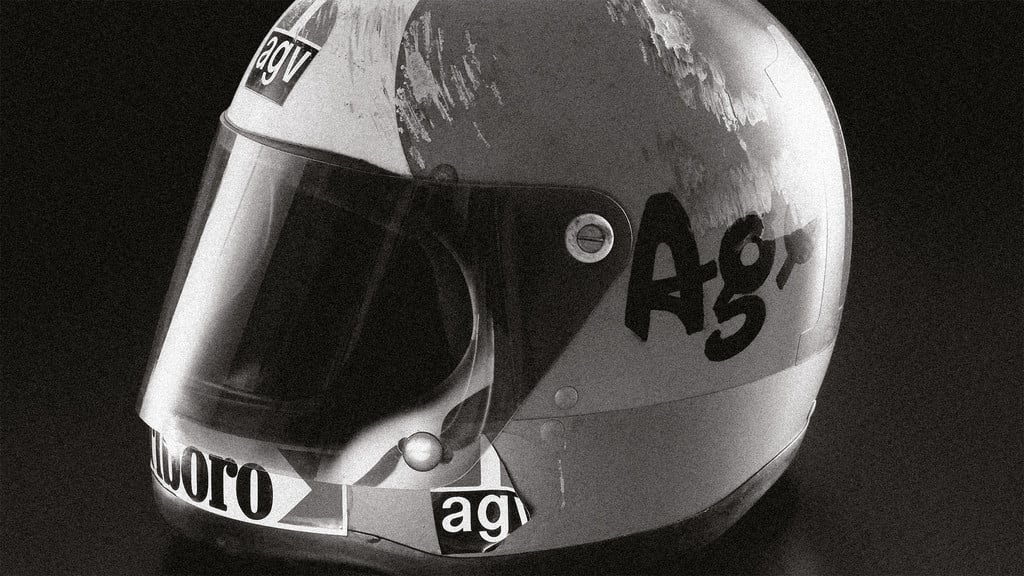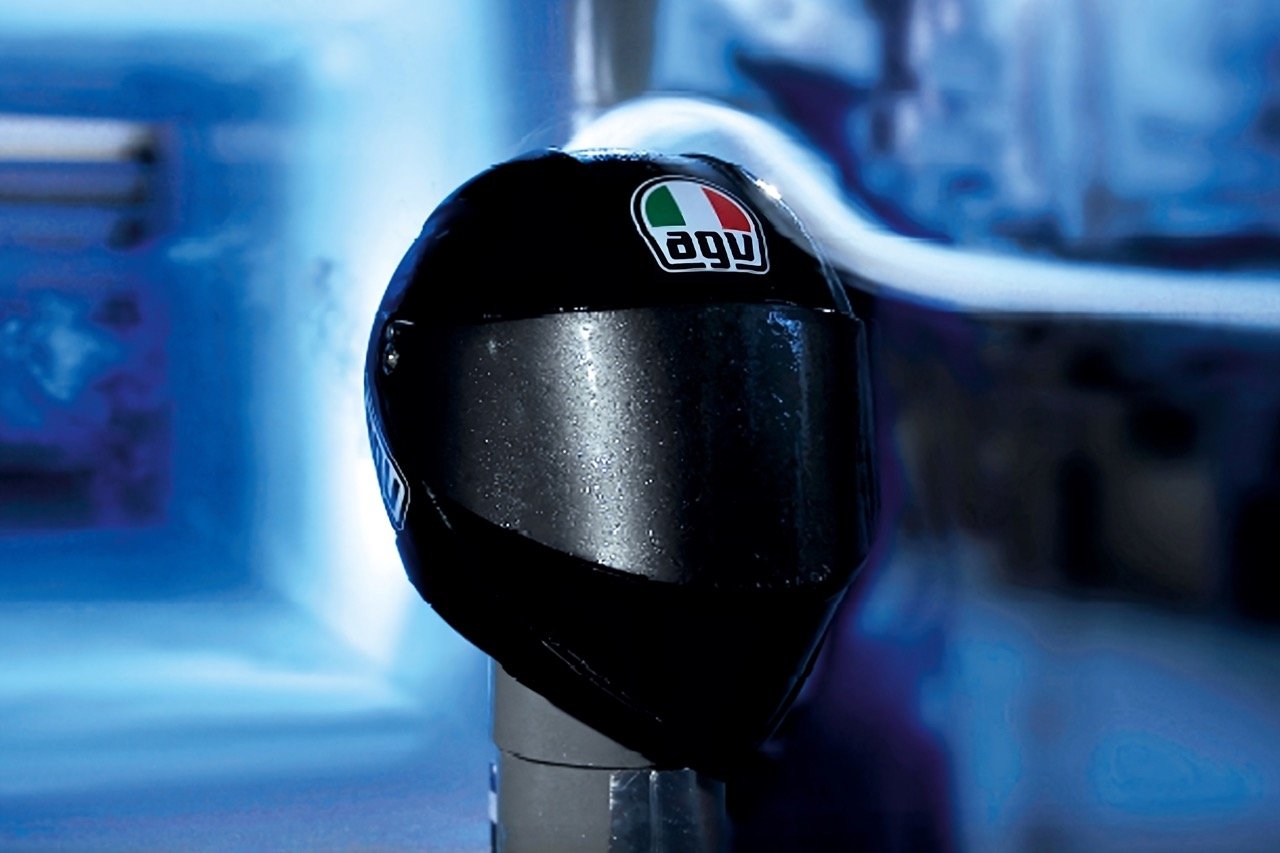Protection and lightness. Ask any motorcycle rider what’s important to them when purchasing a new racing helmet. Their most likely answer will be protection and lightness – that’s why, for the past 50 years, helmet manufacturers have been concentrating their efforts on these two features.
In the early 1970s, Giacomo Agostini tested a full-face helmet for the first time on the very fast Belgian Spa circuit. Legend has it that, on the first lap with the new helmet, as he moved out of the tucked position at 250 km/h to brake hard before a bend, the chinguard and visor started pressing against his face, so much that Ago had to go back to the pits and declared he’d never wear a full-face helmet again when racing. Luckily for him and for us, Ago changed his mind and actually collaborated with AGV to develop the X3000 helmet – comfortable and stable at high speeds. After all, nobody today would even dream of racing with an open-face or ‘pudding-bowl’ helmet, not even on the smallest motorcycles.
Protection and lightness are essential factors when choosing a motorcycle helmet, but they’re not the only ones. Over the past decade, as this sport became more professionalized, with riders performing increasingly extreme feats on all types of motorcycle, manufacturers have attempted to minimize size as much as possible and are focusing on details that, not that long ago, were not considered that relevant, such as helmets’ aerodynamics.

A modern racing helmet must therefore protect from impact, not weigh a rider’s head and neck down, and perfectly cut through the air. It must remain stable on a rider’s face when moving out of the tucked position at high speed. That’s what didn’t happen with Ago’s helmet, made more unstable on the head by its inadequately shaped interior, though it had become obvious that the key factor at those speeds was the ability to cut through the air. After all, the less a helmet cuts through air, the less aerodynamic it is, and the more accentuated is the undesired effect experienced by Agostini’s first helmet that day in Spa.
Talking about lightness, it’s best to clarify the difference between static weight and dynamic weight. Static weight can be easily measured using a normal scale or checked by just picking up the helmet in store. Dynamic weight, on the other hand, is more dependent than static weight on adequate aerodynamic calculations made during the design phase and, therefore, on how the body behaves when immersed in the relevant fluid, air.
Dynamic weight and aerodynamic performance are therefore correlated, and both are affected by the helmet’s silhouette and how it cuts through the air. AGV’s aim is to obtain a product with neutral dynamic weight that, at the required speed – speeds are highly variable among the different segments – won’t press down or pull up the rider’s head.
Every body immersed in a fluid is subject to the fluid’s forces. If we consider air flow, these can be divided into lift and drag. Lift is the force used to make planes fly, or, in very simple terms, it’s a force that during motion pushes a body upward. If the wings were upside down, lift would turn into its alter ego, downforce, which acts in the opposite way and tends to keep an object pressed down on the ground. This is, for instance, what racing car manufacturers have been trying to optimize since the 1970s by adding various aerodynamic appendages to the cars and, more recently, to MotoGP™ motorcycles, too.
Drag, however, as the terms itself suggests, is a force that opposes motion and is what was pressing Ago’s helmet against his face. Drag, unlike lift/downforce, always acts in the direction opposite to motion and it is racers’ number one enemy, as it slows them down.
Here’s a simple example that might help you better understand: When you’re in the car, put your hand out of the window – at a speed of about 40 km/h, you’ll already start feeling the force that the air exerts on it and can see how it changes depending on how you position your hand. In a certain position, your hand will be pushed downward, while in the opposite position it will be pushed up, and in both cases you’ll feel a certain amount of resistance against the direction of movement.

Due to the dynamics of air flows around a rider’s head, a smooth helmet with no appendages sooner or later will start to lift up. The faster the air is, the lower the pressure above and behind the helmet, and therefore the more unstable it will be. Certain models are particularly affected by this as it already starts occurring at 100 km/h. On a motorcycle with good aerodynamic protection, this phenomenon will be felt less.
When riding a MotoGP™ motorcycle, and therefore when riding in the most demanding conditions for both the motorcycle’s components and all the protective equipment, the equipment itself must not trouble, slow down or hinder the rider’s movements in any way. In fact, a rider’s apparel has to be somewhat ‘neutral’ and have a wholly natural fit, so that wearers won’t feel any restraints at all. This is why we need to avoid or contain the helmet lift effect explained above as much as possible, and to achieve this we use technology comparable to that used on sports and racing cars: We designed and developed a spoiler and fitted it on the helmet. On racing helmets, just as on cars, the focus is on downforce or, more precisely, on limiting lift as much as possible.
In 2012, the outcome of this research was the AGV Pista GP. It was a turning point, the first modern helmet to result from testing in a wind tunnel. Now, years later, the Pista GP has reached its third evolution and has been renamed Pista GP RR – the most advanced motorcycle helmet ever developed, the same worn by MotoGP™ professional riders. The Pista GP RR is therefore the latest evolution of the AGV racing helmet, as well as the best to exemplify the importance of aerodynamics.
Owing to the shell’s peculiar shape and the addition of the rear spoiler – which in the current version is called Pro Spoiler – we succeeded in greatly limiting the lift effect, achieving a value of just 1.6 kg at 160 km/h, the approximate average speed on most World Championship circuits. In other words, at this speed the air exerts an upward push on the helmet that’s roughly equal to its weight (1,450 g), so that the two weights cancel each other out and the Pista GP RR ends up having a neutral weight on a rider’s head.
But the most important aspect is the helmet’s overall shape, which eases the ‘stoppage’ of air flows below the helmet itself, also minimizing drag, which owing to the unique wedge design of the chinguard reaches a value of just 4 kg – still at 160 km/h – as well as minimizing the fluctuations created by turbulence, too. The latter phenomenon, termed vortex shedding, is particularly annoying when braking hard, when the rider lifts up over the frame and the helmet is completely immersed in the air. In this situation, both the shape of the Pista GP RR’s chinguard and the spoiler minimize the helmet’s pressure on the rider’s face and the fluctuations engendered by vortex shedding – this greatly assists riders, who benefit from better head stability and a wider field of vision. As a result, this also increases comfort, focus and performance, as riders can focus much better on their external surroundings, both in general and when approaching a bend.
Wind-tunnel study is not only useful in terms of helmets and to enhance riders’ comfort by limiting instability. The optimal integration of all the motorcycle rider’s apparel components also leads to benefits in terms of pure performance, and top speeds in particular, especially with small or mid-sized motorcycles.
In this respect, the pairing of suit and helmet, and especially the profile created by the helmet’s shape with the hump on the back, is crucial. A number of instrumental measurements have established that pairing the AGV Pista GP RR racing helmet with the Dainese Mugello RR D-air® suit – designed to be worn together and to maximize aerodynamic efficiency – allows riders to reach higher top speeds as compared to those achieved when wearing helmets and suits made by other manufacturers, a difference of a few km/h.
That’s an advantage that could potentially make a great difference when riding small motorcycles above all – and particularly in Moto3, where power is limited and top speeds are not as high as in MotoGP™ (where, in 2023, they touched 370 km/h). Moto3 motorcycles – featuring single-cylinder 250 cc engines and about 60 horsepower – reach peaks of between 240 and 250 km/h so that every detail becomes essential.
At Dainese, a paired suit and helmet is just one of the available solutions. The most innovative combinations also include the integration of suit and IN boots, designed to fit inside the suit. Here, too, Dainese technology applied to boots that can fit inside the suit brings benefits in terms of aerodynamics, creating an overall streamlined shape with a clean surface and no appendages at all, superior to that of traditional external boots. This topic was covered in this in-depth article.
The technological content of riders’ protective apparel is progressing hand-in-hand with the increasing performance of racing motorcycles. It’s an obsessive search for perfection that entails the use of sophisticated materials, researching new solutions in all areas – from ergonomics to protection in the strict sense – and painstaking attention to every detail, from head to foot.
This is the only way to provide riders, as well as enthusiasts, with constantly cutting-edge equipment that allows them to give it their all without any constraints, even in extreme situations such as racing on a World Championship circuit at top speed.